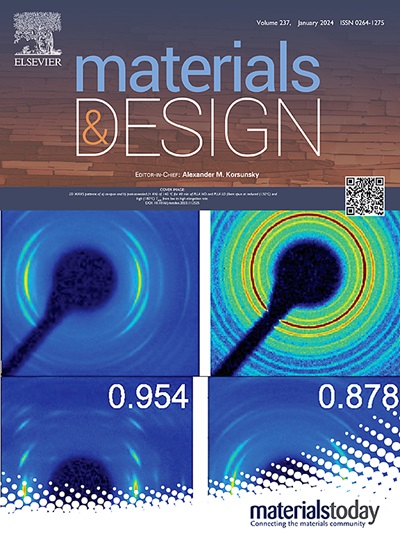Ti和Al掺杂方式对激光定向能沉积CrCoNi中熵合金组织和性能的影响
IF 7.9
2区 材料科学
Q1 MATERIALS SCIENCE, MULTIDISCIPLINARY
引用次数: 0
摘要
采用激光定向能沉积(L-DED)技术,通过元素粉末和预合金TiAl粉末两种掺杂策略,制备了Ti/Al中熵合金。通过OM、SEM、TEM以及298 K和77 K的力学测试,系统表征了其显微组织和力学性能。TEM显示了两种fcc结构的纳米沉淀:Ti2Al2O7和Ti2AlO4的球形复合氧化物孪晶和Ti2Al2O7的包覆Al2O3核壳结构。一个显著的区别在于(CrCoNi)94Ti3Al3样品中析出颗粒的主要球形形态。这是因为预先合金化的TiAl粉末在材料加工过程中使Ti, Al和O更完整地结合,从而有利于顺序氧化和封装形成核壳结构。相比之下,单质Ti/Al掺杂导致核壳相减少,导致整体纳米沉淀密度显著降低,主要是球形氧化物的形成。此外,(CrCoNi)94(TiAl)6合金中存在较高的位错密度。(CrCoNi)94(TiAl)6合金在77 K时获得了优异的力学性能,伸长率为45.0%,抗拉强度为1296.7 MPa,优于(CrCoNi)94Ti3Al3合金。这种增强源于预合金化减少了Ti/Al的燃烧,增加了析出密度和位错积累,从而优化了应变硬化和机械性能。本文章由计算机程序翻译,如有差异,请以英文原文为准。

Effects of Ti and Al doping methods on microstructure and properties of laser-directed energy deposited CrCoNi medium-entropy alloys
CrCoNi medium-entropy alloys with superior mechanical properties were fabricated via laser-directed energy deposition (L-DED), incorporating Ti/Al elements through two doping strategies: elemental powders and pre-alloyed TiAl powder. Microstructure and mechanical properties were systematically characterized through OM, SEM, TEM and mechanical testing at 298 K and 77 K. TEM revealed two FCC-structured nano-precipitates: TiO-coated Al2O3 core–shell structures and spherical complex oxide twins of Ti2Al2O7 and Ti2AlO4. A notable distinction lies in the predominant spherical morphology of precipitate particles within the (CrCoNi)94Ti3Al3 samples. This arises from the pre-alloyed TiAl powder enabling more complete bonding of Ti, Al, and O during material processing, which facilitates sequential oxidation and encapsulation to form core–shell structures. In contrast, elemental Ti/Al doping results in fewer core–shell precipitates, leading to significantly reduced overall nanoprecipitate density, and mainly in the formation of spherical oxides. In addition, higher dislocation density exists in the (CrCoNi)94(TiAl)6 alloy. The (CrCoNi)94(TiAl)6 alloy achieved excellent mechanical properties at 77 K with an elongation of 45.0 % and a tensile strength of 1296.7 MPa, which was superior to the (CrCoNi)94Ti3Al3 alloy. This enhancement stems from reduced Ti/Al burn-off via pre-alloying, which increased precipitation density and dislocation accumulation, thereby optimizing strain hardening and mechanical performance.
求助全文
通过发布文献求助,成功后即可免费获取论文全文。
去求助
来源期刊

Materials & Design
Engineering-Mechanical Engineering
CiteScore
14.30
自引率
7.10%
发文量
1028
审稿时长
85 days
期刊介绍:
Materials and Design is a multi-disciplinary journal that publishes original research reports, review articles, and express communications. The journal focuses on studying the structure and properties of inorganic and organic materials, advancements in synthesis, processing, characterization, and testing, the design of materials and engineering systems, and their applications in technology. It aims to bring together various aspects of materials science, engineering, physics, and chemistry.
The journal explores themes ranging from materials to design and aims to reveal the connections between natural and artificial materials, as well as experiment and modeling. Manuscripts submitted to Materials and Design should contain elements of discovery and surprise, as they often contribute new insights into the architecture and function of matter.
 求助内容:
求助内容: 应助结果提醒方式:
应助结果提醒方式:


